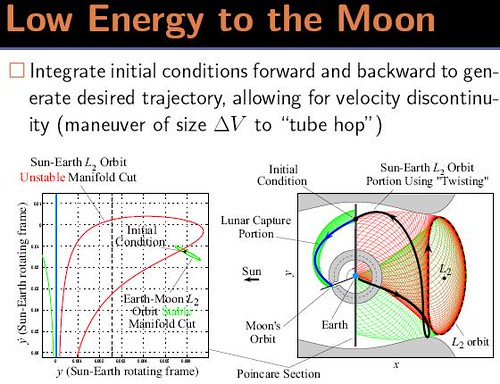Some people have said that the Google Lunar Xprize cannot be won
UPDATE: My idea for the low energy orbital transfer would be sufficient to get a very small robot to the moon using Dnepr (for the google lunar prize). However, the ITN transfer is only 18% more efficient than a Holmann. To save most of the fuel we would need electric propulsion or an ion engine powered tug to move things from low earth orbit to the ITN transfer point. My expanded idea is to use a lot of efficient transfer from LEO to the lunar surface for a lunar space program. This would need the ion or electric propulsion tug from LEO to lunar orbit.
I think winning the prize is doable. Note: the people (Spaceshipone) and teams who tried to win the last xprize collectively spent more than the prize amount. The winners alone spent 2.5 times the prize the amount.
$10 million to get to orbit with a Dnepr rocket. The rules do not say that you have to make your own rocket.
550 kg (with ST-1) to Trans Lunar Injection. Not sure how much the ST-1 stage costs. Probably better to just take the basic rocket to ISS level or slightly higher orbit with about 3000kg and then try to use low energy maneuvers from there.
Probably would have to use the Interplanetary transport network for lower power movement between the earth and the moon
A low energy transfer was achieved from the earth to the moon using the Japanese satellite Hiten
 The Hiten spacecraft that made it from earth orbit to lunar orbit
The Hiten spacecraft that made it from earth orbit to lunar orbit

The basic look of the low energy solution route
There has been a fair bit of theoretical work on the interplanetary low energy gravitional tube system
Hiten weighed about 197kg fully fueled
A slow 5 month maneuver. You are then in lunar orbit. 500-2000kg.

the old lunar LEM, descent module was 10 tons but it was carrying the 5 ton ascent module.
You make a small descent lander. You can make it smaller than Apollo LM modules.
No need to carry ascent module down. No need to carry two astronauts or life support.
Mars Sojourner weighed about 11kg.
You need to make a lineup the Dnepr ride, orbiter stage, plan out the low energy transfer from earth to lunar orbit, descent module and a rover.
There is already a Nasa challenge on the lunar lander. Armidillo seems likely to win that.

the Armidillo lander, which was developed for the 2 million lunar lander challenge
From the xPrize site: The hover times (for the lunar lander challenge) are calculated so that the Level 2 mission closely simulates the power needed to perform the real lunar mission.
So putting this together rocket to orbit, earth orbit to lunar orbit low energy transfer, lunar lander and rover is just a matter of assembling the pieces. My bet is that Armidillo Aerospace can win the Google challenge. The question is why NASA is not sending a constant stream of larger robot vehicles to the moon now using low energy transfers. There should also be ion drive tugs going between the earth and the moon and back again.
FURTHER READING
Google’s blog discusses the reasons for Google’s sponsorship of the prize

Brian Wang is a Futurist Thought Leader and a popular Science blogger with 1 million readers per month. His blog Nextbigfuture.com is ranked #1 Science News Blog. It covers many disruptive technology and trends including Space, Robotics, Artificial Intelligence, Medicine, Anti-aging Biotechnology, and Nanotechnology.
Known for identifying cutting edge technologies, he is currently a Co-Founder of a startup and fundraiser for high potential early-stage companies. He is the Head of Research for Allocations for deep technology investments and an Angel Investor at Space Angels.
A frequent speaker at corporations, he has been a TEDx speaker, a Singularity University speaker and guest at numerous interviews for radio and podcasts. He is open to public speaking and advising engagements.


Comments are closed.